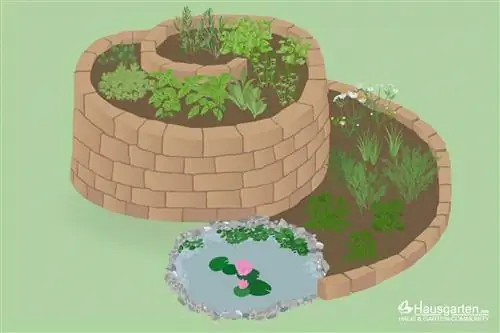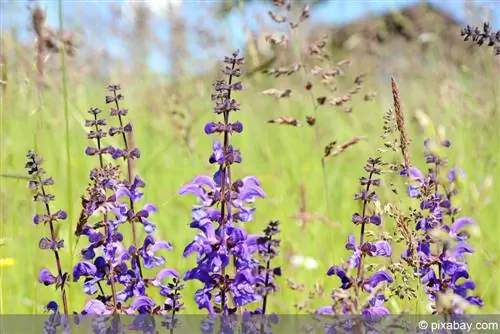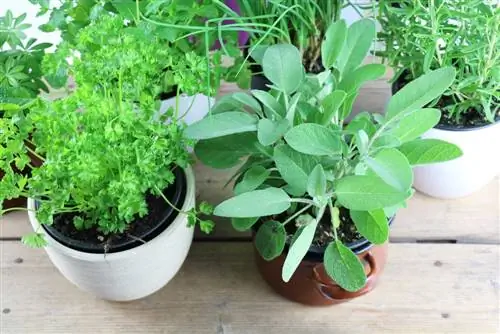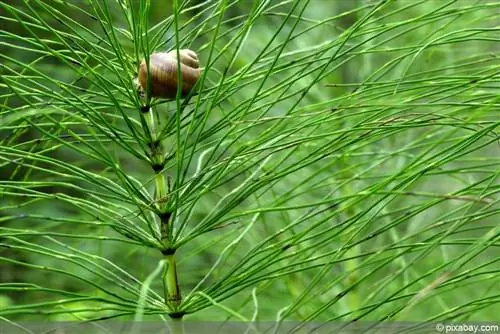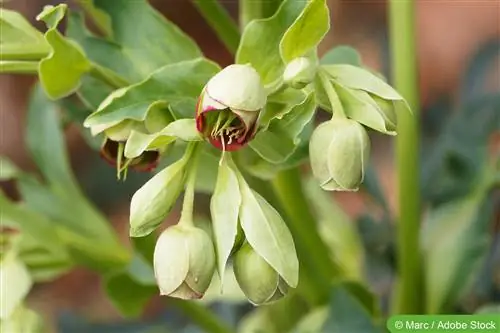- Author admin [email protected].
- Public 2023-12-17 03:39.
- Last modified 2025-06-01 06:48.
horsetail throws down the floral gauntlet to the hobby gardener like no other plant. Wherever the horsetail plant establishes itself in the garden, it is difficult to drive it away. In contrast, Equisetum arvense has a we alth of valuable ingredients that have been used since ancient times to relieve and cure numerous he alth problems. Last but not least, field horsetail naturally cures countless dreaded plant diseases on ornamental and crop plants. Are you unsure whether you should fight horsetail or cultivate it as a medicinal herb? Then follow our attempt at objective decision-making here.
Combat
It is horsetail's unbridled urge to spread that is responsible for its reputation as a fearsome weed. Over the course of almost 400 million years of evolution, the plant developed a highly efficient survival strategy that makes it extremely difficult to completely remove it from the garden. Based on a vegetative and generative propagation strategy, Equisetum arvense takes over every area as long as there is still some sunlight there for photosynthesis. Botanically related to ferns, field horsetail produces a first generation of shoots between March and May that are covered with brownish spores. Following their pollination, the second generation of deciduous main shoots appears, which pose considerable competition to neighboring ornamental and crop plants. At the same time, strong rhizomes grow horizontally and vertically in the soil, which cannot be tackled with normal weeding. Due to its vital growth power, the plant is able to sprout again even from tiny rhizome segments. However, fighting it is not completely hopeless. The following procedures have proven successful in home and allotment gardens to keep field horsetail at least partially under control:
- In the early stages, fight with boiling water, s alt and vinegar (not on sealed surfaces)
- Consistently remove the spore-bearing shoots to prevent pollination
- Where acceptable, lime the soil to raise the pH to the alkaline range that is unfavorable for horsetail
- Rigolen by digging the bed 2 spades deep and cleaning the excavation using a sieve.
- Change the general conditions in the bed by fertilizing, liming, mulching and removing waterlogging
- Cover the affected area with opaque weed film for 6-12 months
Anyone looking for an effective herbicide will be disappointed so far. Horsetail is still ahead in the race with the chemical industry because an explicit control agent against Equisetum arvense has not yet been developed. Since it is a dicotyledonous weed - comparable to Giersch -, manufacturers such as Neudorff or Compo recommend using the special weed killer 'Giersch-frei' or 'Vorox Gierschfrei'.
Tip:
Mowing the lawn regularly makes a valuable contribution to combating horsetail weed in the lawn. Over time, the plant becomes so weakened that it lacks vigor. Additional scarifying and liming in spring enhances the effect.
Respectable medicinal herb
Before we start the nerve-wracking, exhausting and lengthy fight against horsetail, let's take a look at the special advantages of this prehistoric plant. The horsetail plant owes its name to its use for cleaning tin in the Middle Ages. Equisetum arvense only became a weed by definition for plagued farmers and hobby gardeners who have to deal with its immense growth power. In fact, famous healers such as Pliny the Elder or Sebastian Kneipp bowed to its convincing healing effects. It is the special composition of the ingredients that makes field horsetail medically interesting. Its special combination of silica, minerals, essential oils, saponins and other components has a hemostatic, astringent and expectorant effect. We are only talking about the barren, green shoots that thrive in the second generation from May onwards. These are at their peak of effectiveness when harvested between May and July. The following overview shows the outstanding, tried-and-tested applications of field horsetail:
- Arthrosis
- cystitis
- Circulation disorders
- Inflammation of the mouth and throat
- Cold symptoms with cough
- Gout and rheumatism
- Itching
- Kidney inflammation
- Wound healing
Field horsetail predominantly develops its healing properties as a tea. However, the preparation requires a little more effort than usual herbal teas. A teaspoon of dried horsetail is boiled in 300 ml of water for 20 minutes. Only during this long cooking time do the valuable silica and other minerals actually dissolve. The water that evaporates is then replenished. To relieve painful gout and rheumatism, gauze bandages are soaked in the cooled tea and applied. If a wound simply won't heal, repeated applications with cat's tails will help. Athletes use compresses with horsetail tea to strengthen strained tendons and muscles.
Note:
Horsetail should not be used in large quantities or over a long period of time as self-medication without first consulting your doctor. Do not use if kidney or heart activity is restricted.
Even those who enjoy excellent he alth benefit from the beneficial attributes of the medicinal herb. If you add 3 teaspoons of dried horsetail to 1 liter of bath water, this will strengthen the connective tissue in the long term and relieve unsightly cellulite. At the same time, blood circulation is stimulated, varicose veins are reduced and prostate or bladder problems are alleviated.
Tip:
When collecting horsetail, please be aware of the risk of confusion with poisonous horsetail plants. In contrast to horsetail, poisonous species have terminal brownish spore spikes on their green shoots.
Natural pesticide
In the naturally managed hobby garden, horsetail has earned a good reputation for strengthening ornamental and useful plants as well as naturally combating widespread and feared plant diseases. Before you drive Equisetum arvense out of the garden, you should at least know which effective companion you are missing out on. The high silica content strengthens the cell structure. Saponins, essential oils, flavonoids and other ingredients cure fungal infections or keep away voracious pests. Field horsetail has been proven to be effective in the following areas:
- Spray on the buds of soft fruit in spring to ward off diseases
- Dip seed potatoes in horsetail broth for 15 minutes to prevent late blight and brown rot
- Spray against powdery mildew repeatedly on infected plants until the white coating disappears
- Repeated sprays ward off monilia, star soot, lettuce blight and leaf spot diseases
- By adding 15 ml of pure soft soap to 1 l of broth, the solution has a repellent effect on aphids and spider mites
Experienced organic gardeners always have a kettle of horsetail broth at hand. In ecologically oriented gardens, the rich broth is not only used when an emergency plant disease occurs. Mixed with nettle manure, the decoction is sprayed on the ground weekly throughout the season for natural strengthening. Before planting, cabbage varieties are soaked in field horsetail broth to take the wind out of the sails of cunning clubroot. Mixed with clay, horsetail broth makes a practical trunk coating that keeps pests away from fruit trees. From early spring to autumn, the vegetable patch is sprayed once a week in the early morning with a mix of 1/3 tansy tea and 2/3 field horsetail decoction. The medicinal herb also does its helpful work on potted flowers on the balcony. Here you use the tea diluted in a ratio of 1:10 and arm your floral beauties against adversity with weekly sprays.
Field horsetail broth is prepared from 1,000 grams of fresh shoots of the second generation, which are collected between May and July, and 10 liters of water. After the branches have soaked for 24 hours, bring the mixture to a boil and then continue to simmer on a low heat for 60 to 120 minutes. Cover and allow to cool, strain and - depending on the intended use - apply pure or diluted.
You can achieve a more intensive effect with horsetail manure. To do this, take 2 bunches of fresh stalks and place them in a bucket filled with rainwater. Placed in a sunny, warm place and covered with rabbit wire or a rack, fermentation takes 2-3 weeks. During this time, stir the manure every 1-2 days. The unpleasant smell is alleviated by adding bentonite or rock dust. Foaming is desirable during this process and signals a successful outcome. At the end, strain the manure and keep it covered in a partially shaded location.
Conclusion
There is no patent solution to the question of how to properly handle horsetail. Rather, the relationship to the horsetail plant remains ambivalent for hobby gardeners. Rigorous combat costs nerves, time and muscle strength. Giving field horsetail a free hand in the garden also makes no sense. Considering the numerous benefits of Equisetum arvense as a medicinal herb as well as a natural tonic, fungicide and insecticide, the happy medium appears to be the most viable solution. Peaceful cooperation benefits both sides. This means containing the spread to a tolerable extent using the procedures mentioned here. At the same time, the positive sides of Equisetum arvense are used for one's own well-being and the he alth of cultivated plants.


